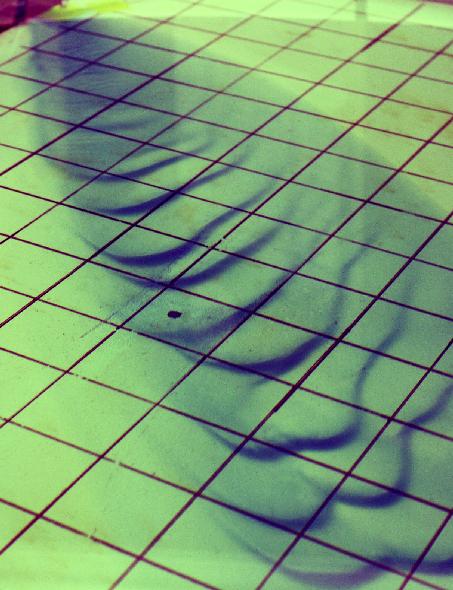Dense Currents
Density-driven currents are generated in the ocean either in marginal seas (e.g. the Mediterranean, Nordic, Red Seas) or on continental shelves (e.g. Arctic and Antarctic shelves), and may flow through topographic constrictions to then descend down the continental slope for long distances. The final properties of these water masses are dictated by the amount of entrainment they experience. They are of global and climatic importance since they are part of the large-scale thermohaline circulation (e.g. Denmark Strait Overflow, Antarctic Bottom Water).
A major result of my work (Cenedese et al. 2004) suggests that subcritical Froude number entrainment could be of primary importance in determining the final properties of dense currents. I recently suggested a new entrainment parameterization obtained using a large data set that includes oceanic and laboratory data (Cenedese & Adduce 2010). The most important aspect of the proposed parameterization is that it allows for subcritical Froude number entrainment and consequently differs substantially from the classical Ellison & Turner (1959) parameterization that is still widely used. This entrainment is of major significance for the ocean since there are several locations where dense currents are observed to be subcritical but their path length to the bottom of the ocean, or to the level of neutral buoyancy, is long (Wåhlin & Cenedese 2006). Weak subcritical entrainment, if it occurs over long distances, could be as effective as strong supercritical entrainment occurring near a sill or a constriction, and would substantially change the final density and location of important water masses in the open ocean. The new entrainment parameterization depends also on the Reynolds number, Re, of the flow, as observed in the laboratory by Cenedese & Adduce (2008). This aspect is not believed to be of importance for the ocean. However, it is fundamental to understand and take into account the Re dependence when comparing laboratory data to ocean observations. Furthermore, Cenedese & Adduce (2010) used a stream-tube model calculation with either the new or the Ellison & Turner (1959) parameterization to simulate the laboratory experiments of Cenedese & Adduce (2008) and the Mediterranean overflow data (Price & Baringer 1994). The results show that the new parameterization leads to significantly improved predictions of density, height, and trajectory of the dense current for low Froude and Reynolds numbers flows when compared to the Ellison & Turner (1959) parameterization, and that it satisfactorily predicts the Mediterranean overflow properties.
Entrainment in dense currents can increase in the presence of topographic irregularities such as canyons or ridges located across the ocean continental shelves and slopes, as shown in a recent collaboration with Anna Wåhlin (U. of Gothenburg) and Gregory Lane-Serff (U. of Manchester) (Wåhlin et al. 2008). Canyons and ridges can funnel the dense fluid downslope and increase the velocity and consequently the Froude number of the current. On the other hand, generation of internal waves by a dense current flowing down a slope may decelerate the flow, with a consequent reduction of Froude number and entrainment. A study with Jeroen Hazewinkel (GFD Summer Student Fellow) shows that internal waves do radiate from the nose of the dense current. However, a comparison of the measured nose speed with that predicted by an analytical model that does not account for internal waves shows good agreement. This indicates that internal waves are not responsible for a large reduction of the dense current speed (Hazewinkel, 2008).

Wave Regime. (M. Ohiwa)

Picture showing the three-dimensional waves. The ‘‘backward breaking’’ of the wave crests is also visible, as indicated by the lighter gray regions. (Cenedese et al., 2004)
References
Cenedese C., and Adduce C., 2010. A new parameterization for entrainment in overflows. J. Phys. Oceanogr., 40, 1835-1850.
Cenedese C., and Adduce, C., 2008. Mixing in a density-driven current flowing down a slope in a rotating fluid. J. Fluid Mech., 604, 369-388.
Cenedese, C., Whitehead J.A., Ascarelli T.A., and Ohiwa M., 2004. A Dense Current Flowing down a Sloping Bottom in a Rotating Fluid. J. Phys. Oceanogr., 34, 188-203.
Ellison, T.H., and Turner, J.S., 1959. Turbulent entrainment in stratified flows. J. Fluid Mech., 6, 423-448.
Hazewinkel, J., 2008. Internal wave radiation by gravity currents down a slope. Woods Hole Oceanog. Inst. Tech. Rept. WHOI-2008-01 (Woods Hole Oceanog. Inst., Woods Hole, Mass., 2008).
Price, J.F., and Barringer, M.O., 1994 Outflows and deep water production by marginal seas. Progress in Oceanography, Vol. 33, Pergamon, 161-200.
Wåhlin, A.K., and Cenedese C., 2006. How entraining density currents influence the ocean stratification. Deep Sea Res. II, 53, 172-193.
Wåhlin, A.K., Darelius, E., Cenedese C., and Lane-Serff G.F., 2008. Laboratory observations of enhanced plume entrainment in the presence of submarine canyons and ridges. Deep Sea Res. I, doi:10.1016/j.dsr.2008.02.007.